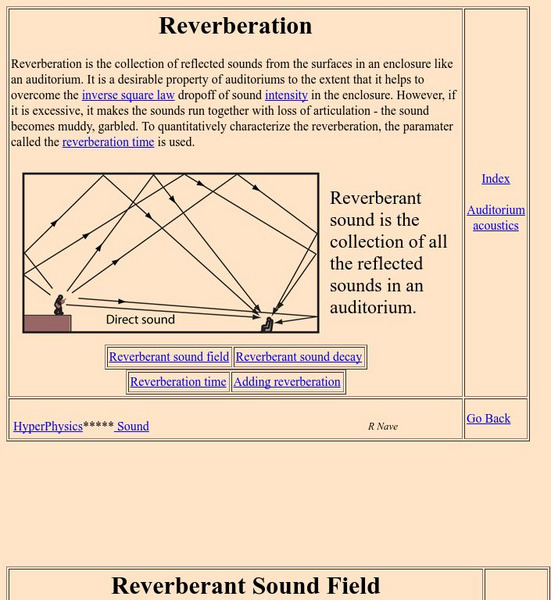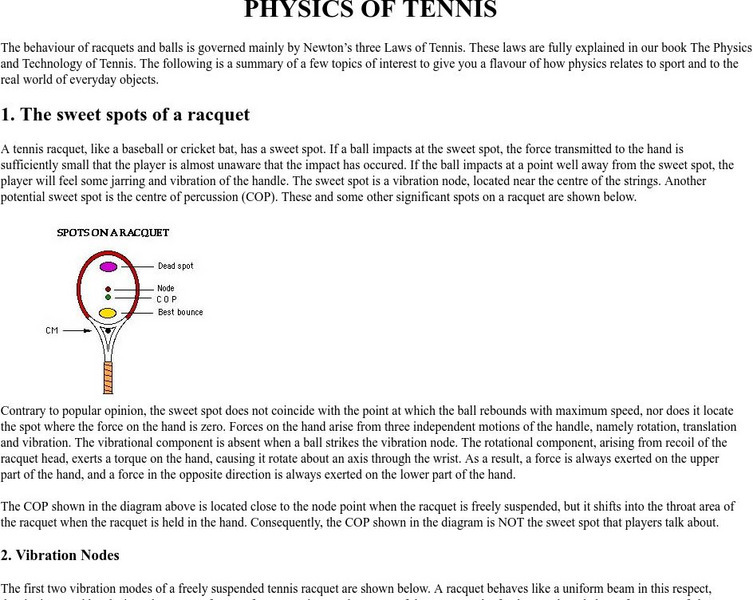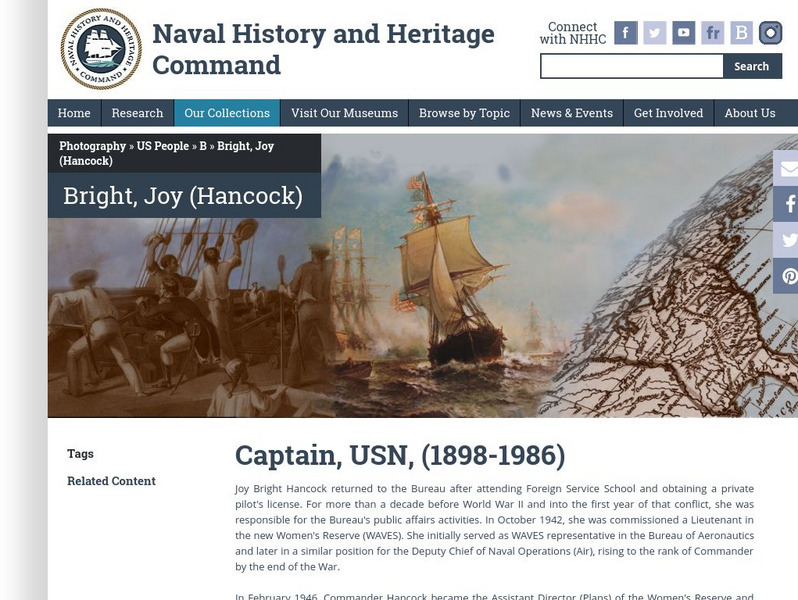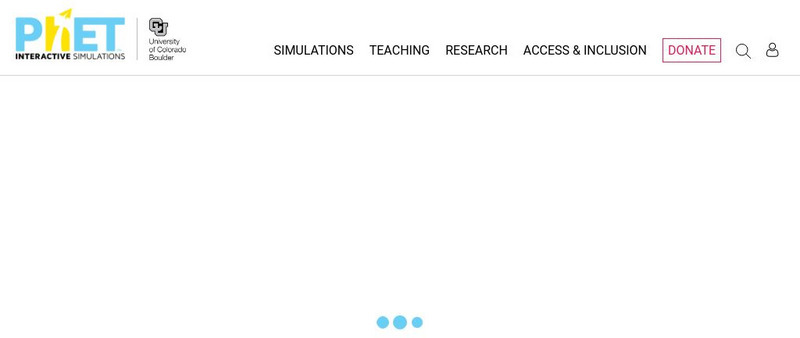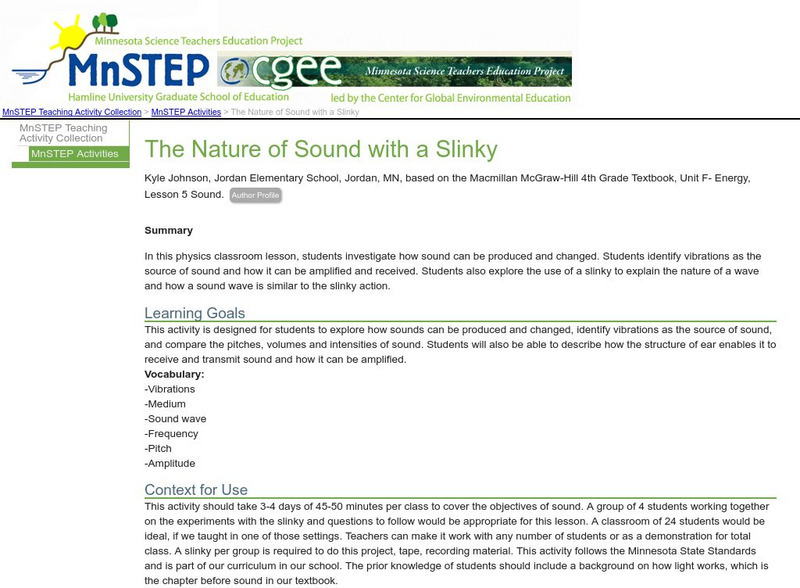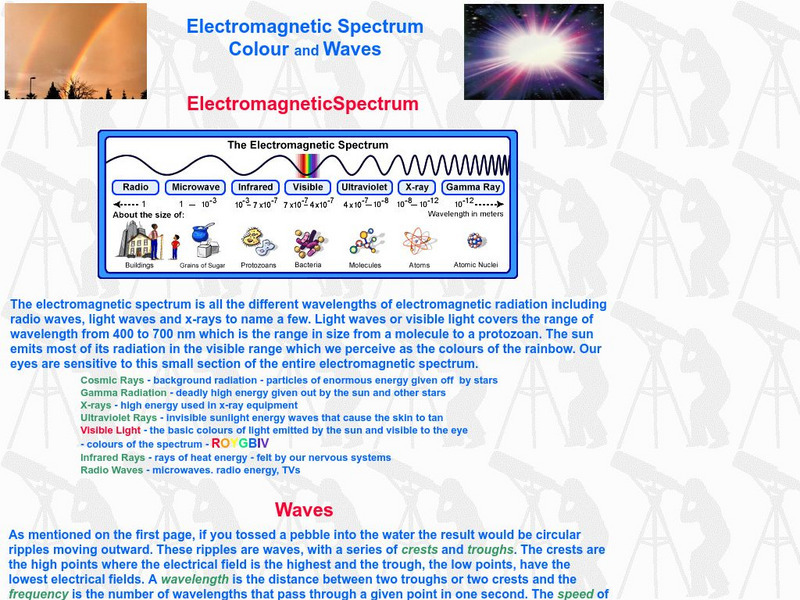Georgia State University
Georgia State University: Hyper Physics: Water Tube Resonance Experiment
Online physics lab experiment in which students use resonating waves inside of a closed-end air column to determine the speed of sound. The form allows students to check their answers and receive immediate feedback.
Georgia State University
Georgia State University: Hyper Physics: Reverberation
A tutorial from a hypertext physics course book that discusses reverberation. Illustrated.
Georgia State University
Georgia State University: Hyper Physics: Sound Level Measurement
Home page for a hypertext physics course. Users can access subjects ranging from the sound wave parameters that effect hearing and communication to OSHA worplace standards.
Georgia State University
Georgia State University: Hyper Physics: Refraction of Sound
A discussion of refraction and its application to sound waves. Using analogies, graphics and real-life applications, this page and those that accompany it explain why and when sound waves bend.
Georgia State University
Georgia State University: Hyper Physics: Resonance
This hypertext physics course surveys sound resonance in musical instruments. Illustrated.
Georgia State University
Georgia State University: Hyper Physics: Sound and Hearing
Home page for a hypertext course on physics. Accesses a range of topics from hearing to sound measurement to sound propoation to musical instruments.
NASA
Rxte Learning Center: Frequency, Wave Length, and Energy Activity
Resource focuses on the relationship between the frequency, wavelength and speed of light. Has a link to an interactive activity relating frequency, wavelength, and energy.
Pennsylvania State University
Kettering University: The Simple Harmonic Oscillator
The motion of three simple harmonic oscillators is animated to illustrate the effects of mass and spring constant upon the motion. Several equations and a lengthy discussion accompany the animations.
University of Sydney (Australia)
University of Sydney: Tennis Racket Physics
An illustrated discussion about the physics principles associated with tennis rackets and sweet spots.
University of Maryland
Thinking Problems in Oscillations and Waves: Mass on a S
A series of thought-intensive, multichoice questions from the University of Maryland concerning masses on springs. A downloadable software program on the topic is also included.
Wolfram Research
Wolfram Science World: Maxwell, James
This ScienceWorld site describes the Scottish mathematician and physicist James Maxwell (1831-1879) who published physical and mathematical theories of the electromagnetic field.
University of Toronto (Canada)
University of Toronto: Flash Animations for Physics
This site boasts an extensive list of physics animations that cover topics such as electricity, magnetism, quantum mechanics, and relativity. Variables can be manipulated for each demonstration.
Texas Instruments
Texas Instruments: Holt Physics Chapter 11: Vibrations and Waves Pendulum Lesson
This activity Pendulum from Holt Physics Chapter 11 Vibrations and Waves uses the calculator and the VIB program calculate the period of a pendulum on different planets.
Space Telescope Science Institute
Amazing Space: Star Light, Star Bright
An online exploration where students learn the basics about light and the properties of waves and the electromagnetic spectrum. Students will also learn how to measure wavelength and frequency so they can understand the electromagnetic...
US Navy
Naval History and Heritage Center: Captain Joy Bright Hancock
A site from the Naval Historical Center provides biographical information on Joy Bright Hancock (1898-1986), champion for women in the Armed Services.
University of Colorado
University of Colorado: Ph Et Interactive Simulations: Wave Interference
Conduct virtual experiments with water, sound, and light waves to determine the sine wave and patterns created in each.
Science Education Resource Center at Carleton College
Serc: Exploring Sound: Length Makes a Difference
Students begin to explore the relationship between the length of an object and the sound it produces as it vibrates, by using a wood or plastic ruler and the edge of a desk or table.
Science Education Resource Center at Carleton College
Serc: The Nature of Sound With a Slinky
A physics lesson where students investigate how sound can be produced and changed. Students identify vibrations as the source of sound and how it can be amplified and received, and then explore the use of a slinky to explain the nature...
PBS
Pbs Learning Media: Frequency
Frequency is how often something occurs. This interactive resource details the definition of frequency, offers demonstrations, and features examples.
Simon Fraser University
Chem1 Virtual Textbook: The Language of Light
Acting as a subtopic of the General Chemistry Virtual Textbook's section on Atoms and the Periodic Table, this site discusses light in relation to particles and waves. The difference between particles and waves is addressed along with...
Creative Science Centre
Creative Science Centre: Three Wave Tanks a Se Pnet Project
Gives descriptions of three different water wave tanks that were build for an exhibition.
Museum of Science
The Atom's Family: Radiometer
Help Dracula find out about light waves by using a virtual radiometer.
Purdue University
Purdue University: An S and P Wave Travel Time Simulation
A classroom simulation modeling how earthquake waves travel through Earth at different speeds. A graph is constructed to demonstrate the relationship between the distance and time of travel of seismic waves, and then used to locate the...
My Science Site
Electromagnetic Spectrum: Colour and Waves
This resource provides information on the different wavelengths that make up the electromagnetic spectrum. Also contains information on waves and color.



